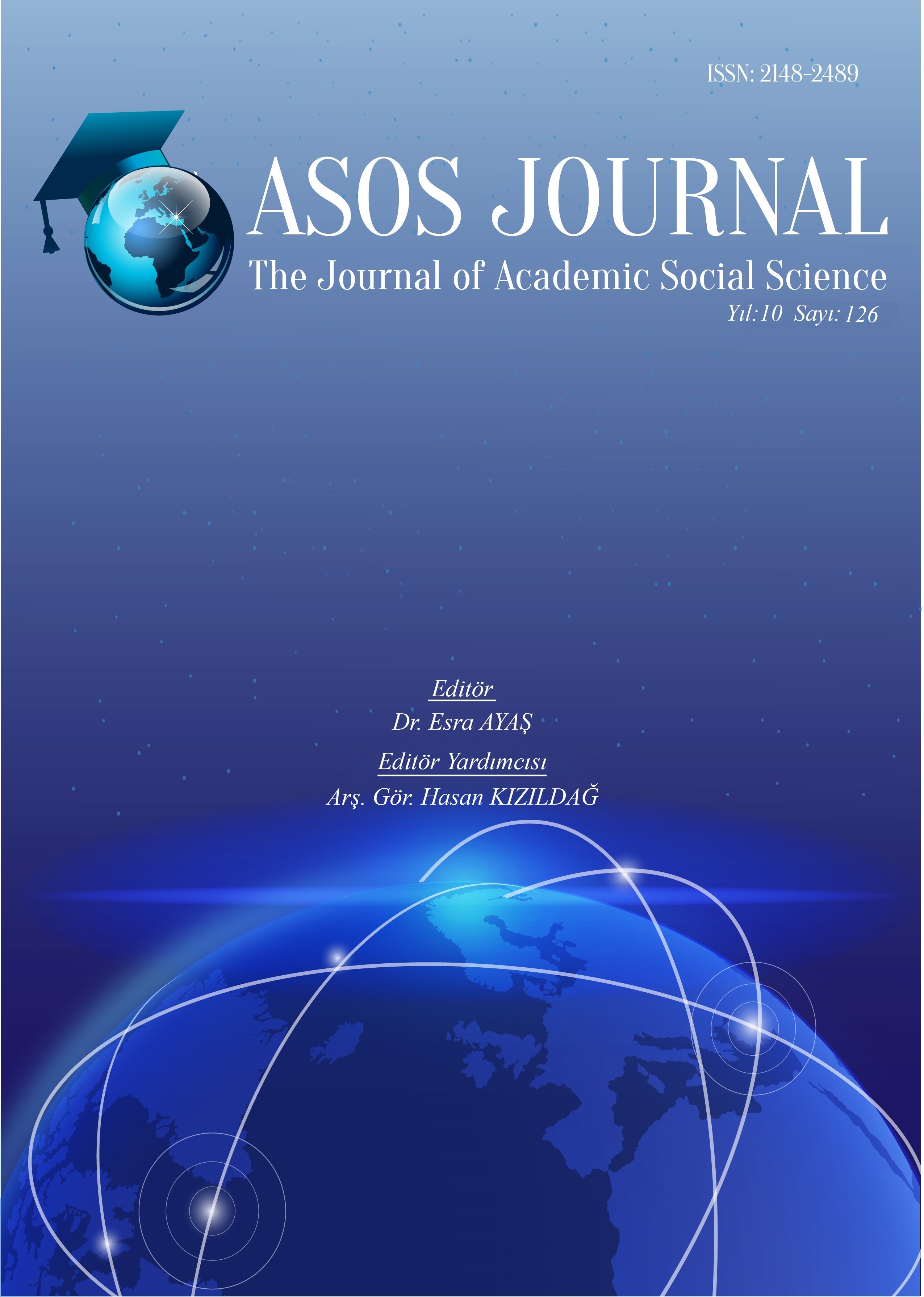Author :
Abstract
Makale çalışması, 18.04.2004-08.08.2004 tarihleri arasında Almanya Modern Sanatlar Müzesinde gerçekleştirilen (ZKM Karlsruhe) “Ara beni benim adım İstanbul” (Call Me Istanbul is My Name) sergisinde yer alan bir enstalasyon çalışmasının oluşum sürecini kapsamaktadır. Kişisel Mitoloji ve görsel hafıza kavramlarına dayanan çalışma, mimarlık ve tekstil tasarımı eğitimi almış İstanbul doğumlu sanatçının, mekân simülasyonu deneyimi yaşatma hedefi ile gerçekleştirdiği bir uygulamadır. Uygulanan keçe nesnelerden oluşan kurguda, devinim, dış mekân sesi gibi eklenti unsurlardan alınan performatik destek ile görsel hafıza ve çoklu duyuları tetiklemesi hedeflenmiştir. Disiplinler arası yaklaşımla müze camekânından kaçan nakışlı bir keçe seccade senaryosu yazılarak kişileştirilmiştir. Öykü gereğince oryantalist yaklaşımla İstanbul semalarından uçurulan seccadenin gözünden, kültürler arası ilişkilerin birikiminden kalan mimari yıkıntı katmanlarının dökümü alınmıştır. Elde edilen veriler, kurgu seçiminde ve kumaş panolarda simgelenmesinde yol gösterici olmuştur. Bizans, Osmanlı ve sonrasının kültürel simgelerini ortak bir oluşumda gösterme amacıyla gerçekleştirilen çalışmada, semt pazarlarının asma-germe tentelerinin mimari uygulaması örnek alınmıştır. Şehrin tarihinde ki mevcut farklı kültürel simgeler, uygulaması gerçekleştirilen keçe panellerle yansıtılmıştır. Enstalasyon çalışmasında, konik formda yerden yükselen mezar taşları, heykelsi keçe üniteler, döner mekanizmalardaki askılardan inen kişileştirilmiş kostümlerle buluşturarak bütünlük sağlamıştır. Vapur, ezan, sokak satıcıları ve martı çığlıkları gibi İstanbul’un simgesel dış mekân sesleri ön kayıt yapılmış ve sergi sürecinde mekânda dinletilerek temanın etkisi kuvvetlendirilmiştir. Böylelikle izleyicinin bireysel hafıza kayıtlarına dokunma, yeniden canlandırma ve yaşatma olasılıkları arttırılmıştır. Kişisel mitoloji yaklaşımı ve görsel hafızadan simgeleştirilen bir simülasyon kurgusu, farklı mekânlardan alınan kesitlerin birbirleriyle ilişkisi ve bir bütüne varma metoduyla izleyiciye İstanbul deneyimi yaşatmak amaçlanmıştır.
Keywords
Abstract
The article study covers the formation process of an installation work in the exhibition "Call Me Istanbul is My Name" (Call Me Istanbul is My Name) held at the German Museum of Modern Arts (ZKM Karlsruhe) between 18.04.2004-08.08.2004. The work, based on the concepts of Personal Mythology and visual memory, is an application realized by the Istanbul-born artist, who has studied architecture and textile design, with the aim of providing a space simulation experience. In the fiction, which consists of applied felt objects, it is aimed to trigger visual memory and multiple senses with the performatic support taken from additional elements such as motion and outdoor sound. With an interdisciplinary approach, an embroidered felt prayer rug escaping from the museum window was personified by writing a scenario. According to the story, the layers of architectural ruins left from the accumulation of intercultural relations were taken from the eyes of the prayer rug, which was blown from the skies of Istanbul with an orientalist approach. The data obtained has been a guide in the selection of the fiction and its symbolization on the fabric panels. In the study, which was carried out to show the cultural symbols of the Byzantine, Ottoman and later periods in a common formation, the architectural application of the suspended-tension awnings of the district bazaars was taken as an example. The different cultural symbols in the history of the city are reflected with felt panels. In the installation work, tombstones rising from the ground in conical form, sculptural felt units, and personalized costumes descending from the hangers on the revolving mechanisms have provided integrity. The iconic outdoor sounds of Istanbul, such as the ferry, the call to prayer, street vendors and the cries of seagulls, were pre-recorded and played in the venue during the exhibition process, thus enhancing the effect of the theme. Thus, the possibility of touching, reviving and keeping alive the individual memory records of the audience has been increased. It is aimed to give the audience an Istanbul experience with a personal mythology approach and a simulation setup symbolized from visual memory, the relationship of sections taken from different places with each other and the method of reaching a whole.
Keywords
- Appadurai, A. (1986). “The Social Life of Things”, “Commodities in Cultural Perspective”. UK: Cambridge Universty Press.
- Bal, G. (2003). Topkapı Sarayı’nda Keçe Sergisi. Türkiye’nin Plastik Sanatlar Dergisi. Eylül/Ekim Sayısı. s. 80-82.
- Başer, İ. (1992). Elyaf Bilgisi. İstanbul: Marmara Üniversitesi Yayınları.
- Benjamin, W. (1999). Arcades Project. The President and Fellows of Harvard College. ISBN 0- 674-04326-X.
- Bunn, S. (2010). Nomadic Felts (Artistic Traditions in World Cultures). Londra: British Museum Press.
- Campbell, J. (2000). Kahramanın Sonsuz Yolculuğu. İstanbul: Kabalcı Yayınevi.
- Dormer, P. (Edited by) (1997). The Culture of Craft, Status and Future (Studies in Design and Material Culture). Manchester and New York: University Press. ISBN 13: 9780719046186.
- Feuerstein, M. and Read, G. (Edited by) (2013). Architecture as a Performing Art. UK: Routledge Press.
- Gürışık, H. S. (2004). Ara Beni Benim Adım İstanbul. Sergi Kataloğu, İstanbul: ZKM.
- İnalcık, H. (2008). Türkiye Tekstil Tarihi Üzerine Araştırmalar. İstanbul: Türkiye İş Bankası Kültür Yayınları. ISBN: 978-9944-88-458-7.
- Neret, G. (1999). Henri Matisse. South Korea: Published by Taschen, Koln.
- Özdemir, M. ve Özyer, H. (2013). İzmir İli Tire İlçesinde Keçe Yapımı. Uluslararası Sosyal Araştırmalar Dergisi. Cilt: 6, Sayı: 2, Volume: 6, Issue: 25. s. 364-381.
- Stachelhaus, H. and Britt D. (1974). Joseph Beuys. New York: Abbeville Press. ISBN 1-55859- 107-9.
- Tabrizi, S. (2004). Me & Rumi: The Autobiography of Shams-I Tabrizi. Published by Fons Vitae. ISBN 13: 9781887752527.
- Zevi, B. (1990). Mimarlığı Görebilmek. İstanbul: Birsen Yayınevi.
- https://www.theguardian.com/artanddesign/2015/mar/13/frei-otto (Erişim Tarihi: 13.12.2021).
- https://news.artnet.com/market/sean-kelly-brings-group-of-iconic-joseph-beuys-artworks-to- armory-felt-suit-already-sold-3719 (Erişim Tarihi: 13.12.2021)
- https://www.badische-zeitung.de/der-kuenstler-joseph-beuys-polarisiert-bis-heute-- 201750063.html (Erişim Tarihi: 13.12.2021)





